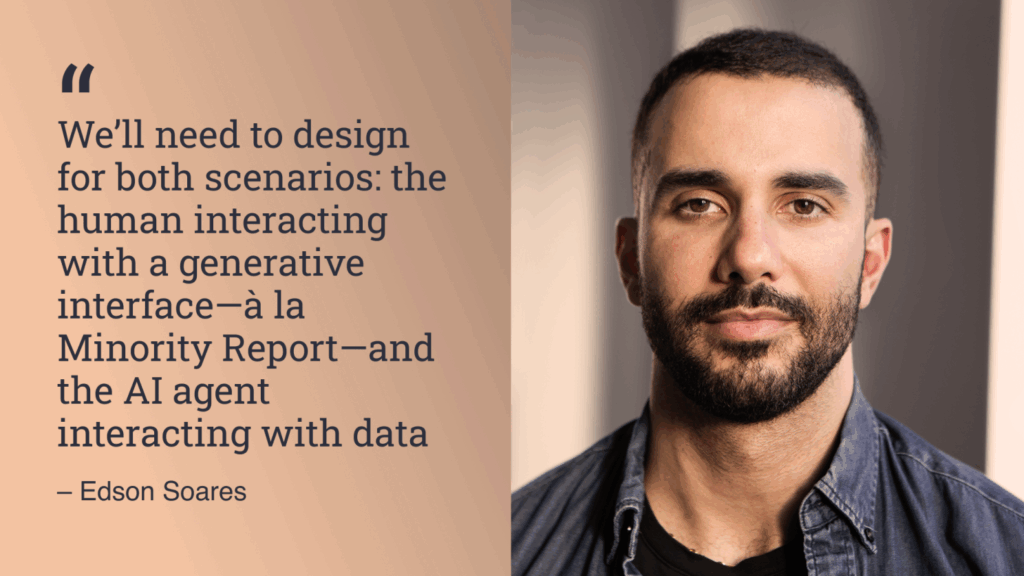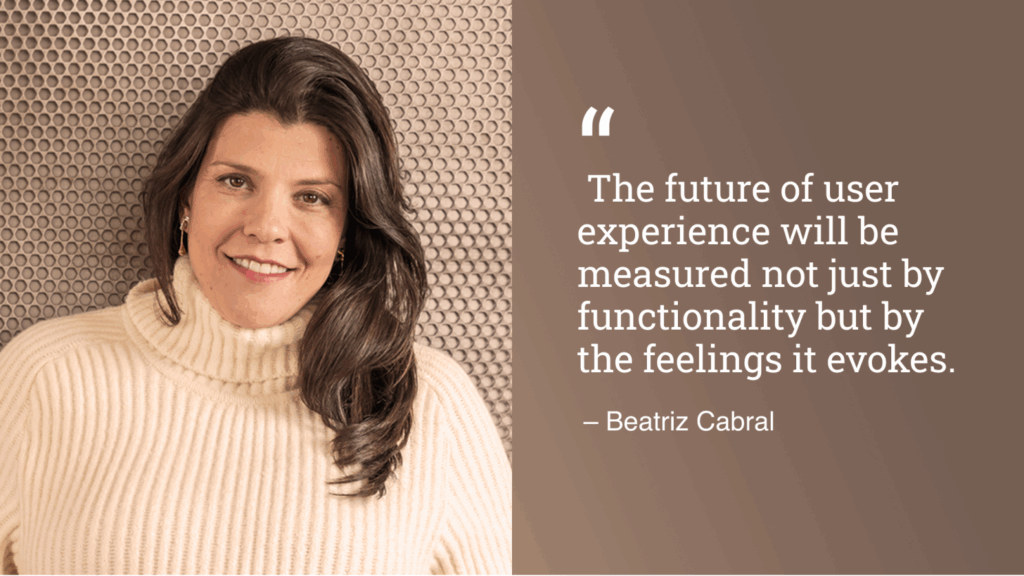Since the early 00s, corporate business strategy has recognized the value of User Experience (UX). This recognition coincides with the rise of smartphones, social media, and mobile apps. The real test came during the pandemic when we suddenly relied on screen-based experiences to do almost everything. Today, the discipline is being challenged again with the explosion of Generative AI. What is the future of UX in a world mediated—and even created—by AI? That’s the question Beatriz Cabral and I debated in a conversation that could’ve been a podcast but became this article.
We both have experience in the field. I, Edson Soares , Designer, and Technologist, held UX and Design Lead roles at companies like IBM and Capital One and am the founder of the design studio feelscience. Beatriz Cabral led the UX team at Grupo GOL Smiles and was responsible for developing the Tangerina Design System, a project in partnership with Môre, which won the iF Design Award in 2025.
In our conversation below, we’ll share our stories and perspectives on the following topics:
1. Why talk about the future of UX now?
2. Is this the end of UX?
3. A new designer - hybrid, ethical, and provocative
4. New ways of working
5. Consciousness, authenticity, and human connection
6. References for further exploration
1. Why talk about the future of UX now?
E. The rise of generative AI has created a new way of delivering value and a new interaction model. Users are getting used to having their “wishes” fulfilled almost instantly. Want to book a flight? AI will do everything for you and ask you to confirm payment. In this new context, the user doesn’t need to go through multiple screens to finalize the purchase. That’s revolutionary because it drastically shortens the time between intention and outcome. Even if it’s currently limited to tech-savvy consumers, this model will become the dominant way of interacting with products and services.
B. We’re entering a new era where UX intertwines with AI, business strategy, and systems thinking. Designers have always gone beyond screen creation, but now, more than ever, they are shaping behavior, building trust models, and setting ethical boundaries. In your example, even users who feel unsure during any part of the buying journey will be able to feel confident. The process becomes more comfortable and effective.
2. Is this the end of UX?
E. Anyone saying AI means the end of UX is just clickbaiting. The original concept of User Experience always involved more than screens. Any interaction we experience provokes an emotional reaction—whether with partners, kids, bosses, or products and services. In this AI-mediated world, emotional responses still exist. People who think UX is just what happens on a screen conclude that designers will become irrelevant. But that’s a premature take, especially when issues of emotion, privacy, ethics, and user autonomy arise. It’ll naturally force professionals from other disciplines to mature their understanding of UX. I believe the discipline is more important than ever. What will AI-driven interactions trigger in users? How do we preserve the original intent of a company’s value proposition? How do we prevent inappropriate or dangerous use cases?
B. I agree. UX is not in danger but in transition. UX work will continue to exist but may be distributed differently across organizations—like what happened with digital transformation and innovation teams. What once was a centralized team may be spread into multidisciplinary teams, making design a cross-functional capability. Experience design has always been—and will always be—about understanding and improving interactions between people and systems. As those interactions grow more complex, the designer’s role expands, too. As the brilliant Ollivia Maria Gonçalves 🏳️⚧️ says, design remains a method for deciding, creating, and transforming.

3. A New Designer - Hybrid, Ethical, and Provocative
E. I like what you said about UX Designers spreading across teams in a decentralized model. I’ve always seen the title "UX Designer" as both a privilege and a burden. After nearly a decade in the field, I’ve realized that being a UX Designer isn’t about owning the user experience. That’s an unrealistic expectation many young designers have. In practice, a UX Designer is a facilitator, a provocateur, a defense attorney, a prototyper of the future, and (especially) a salesperson. Responsibility for the user experience lies with everyone involved. Many companies have already swapped the title “UX Designer” for “Product Designer” or “Service Designer,” which I find more accurate. I don’t know which titles will dominate in this new era, but we’re already seeing a new jargon emerge: AX, for Agent Experience. We'll need to consider how to design experiences that include AI Agents. Using the earlier example of the agent booking a flight, the agent doesn’t need a screen to complete a task. I believe, for a while, we’ll need to design for both scenarios: the human interacting with a generative interface—à la Minority Report—and the AI agent interacting with data.
B. AI is redefining how experiences are designed. In the flight-booking agent example, conversational interfaces, personalization at scale, and automated decision-making demand designers go beyond layout design to understand the nuances of human-machine interaction. That means creating experiences that balance efficiency and control, ensuring automation doesn’t strip users of their ability to choose. One of the key points John Maeda raised at this year’s SXSW is that designers must ensure AI agents act ethically and transparently, preventing automation from creating user barriers. He also highlighted the concept of “human regret”: design must allow users to review and change decisions, giving them more control over their choices.
E. In this context, where agents play an active role in the user journey, there’s enormous potential for service design. As experiences become faster, we’ll need to focus on the journey and the moments that truly matter. If we’re not careful, speed becomes a shortcut, and the moments originally meant to build trust, clarity, and connection become friction or errors. Service design provides tools to organize workflows across multiple touchpoints and actors. It becomes essential for identifying bottlenecks, opportunities for automation, and how internal agents from organizations interact with external agents representing the user’s interests.
4. New ways of working
E. What’s interesting is that everything we’re saying about user journeys, ethics, and feelings relates to abstract elements. But things have changed entirely if we look at tangible artifacts like screens. As content creation becomes democratized, designers must position themselves as curators, creative directors, and strategists. I mentioned earlier that that we’ll have to design for AI agents. If we need to think about the data used in APIs, designers must think like developers or linguists. And if we can prototype interfaces with just prompts, product managers won’t need designers to visualize the experience. The roles of Designers, Engineers, and Product Managers are starting to overlap. This will accelerate prototyping and learning cycles, create new roles, and spark new collaboration models. However, the practice of designing user interactions with products and services remains.
B. We’re seeing UX merging with other fields and a growing need for designers to expand their skill set beyond interfaces. They won’t just use AI—they’ll design with it, guiding how intelligent systems adapt, learn, and show up in people’s lives. Designers are already working beyond screens—on wearables, voice interfaces, and spatial computing. The challenge isn’t to follow AI but to lead it. The UX of the future won’t be a static flow but a living, responsive system that adapts in real time to people, environments, and intentions. UX professionals will need to understand the impact of their decisions on business and society deeply. Soft skills, systems thinking, and a holistic view of experience will be key. AI might replace some technical aspects of UX, but it will never replicate what makes the discipline truly human: empathy, intuition, and consciousness.

Credit image: Studio Ghibli
5. Consciousness, Authenticity and Human Connection
E. Consciousness is a key element. AI's quick responses don't always match human processing capacity. And by "processing," I mean the ability to internalize an insight. In terms of workflows, AI can help a lot with data analysis. However, decision-makers still need time to absorb that data, evaluate it critically, and make conscious decisions. In scenarios with multiple decision-makers, human facilitation will still be necessary. Beyond conscious decision-making, we also have ethical considerations—no longer something you tackle at the end of a process but something that needs to be embedded during research and ideation when we decide which data and mental models to use for training AI. Are we introducing biased, exclusionary thinking? Are we pushing users to accept something they should be questioning? For example, the flood of images created with chatGPT that copy Studio Ghibli's signature style. Is that fair use? Do most people even know those cute images reproduce Miyazaki's style?
B. As we see in the article by Sérgio Branco and Júlia Veloso on Medium, OpenAI (responsible for ChatGPT) seems to have changed their interpretation of fair use because it used to be that the system would restrict similar prompts until recently. Now, it’s possible to create images in Ghibli style and The Simpsons or Turma da Mônica. Authenticity will be an essential competitive edge for meaningful UX in a landscape where automation can make experiences feel impersonal. We’ve spent years optimizing usability. The next step is designing for emotional resonance—trust, delight, consciousness, safety, and peace of mind. The future of user experience will be measured not just by functionality but by the feelings it evokes.

6. References for further exploration
Google’s People + AI Guidebook – great practical frameworks for designing with AI
IBM Design for AI – solid principles and ethics around human-centered AI
Adobe’s Future of Creativity Report – insights into how generative AI is reshaping design
Nielsen Norman Group – AI UX Articles – trusted, research-based UX thinking with AI context
How Service Design Will Evolve with AI Agents
Hello AI Agents: Goodbye UI Design, RIP Accessibility
John Maeda’s Design and Tech Report 2025
As mãos de Miyazaki e os algoritmos da OpenAI
We’re sharing our thoughts and references because we believe this topic is open to debate. And you—what do you think about all of this? Join the conversation in the comments.
Article originally posted on LinkedIn
No Comments.